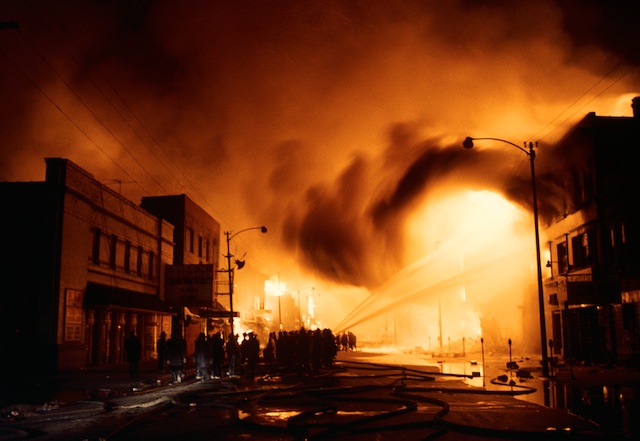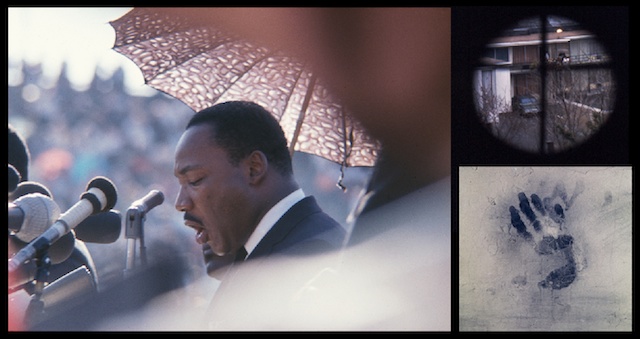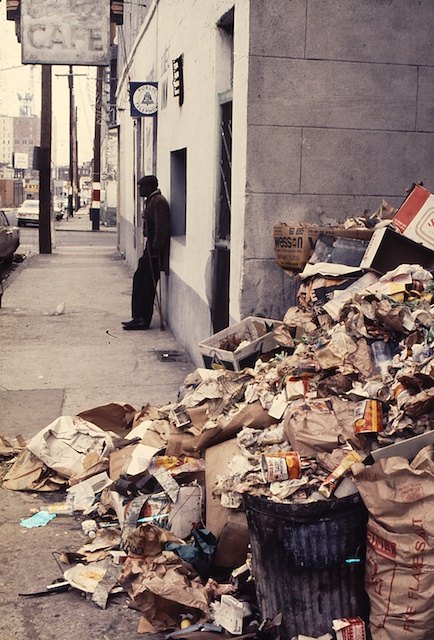From the Vault of Art Shay: Remembering Dr. King
By Staff in News on Jan 12, 2011 5:00PM
The citizens of Trumbull Park, and other anti-black sympathizers from Chicago and other entrenchments, turned out about 3,000 strong to help the residents keep a brave young black couple from renting a Trumbull Park apartment. A thousand police responded and an all-night watch of a dozen officers formed a Rembrandt-like nightwatch for the harassed couple. It was a fortuitous occurrence for Life magazine. They had just started a \"fast closing\" color page for breaking news and my picture (shot with a 4x5 inch Linhof camera fans) became the first of these. The garbage cans had holes punched in them and coal burned for warmth. For some arcane reason the cops, to this day, call their fiery street cans \"salamanders.\"\r\n

On Wacker Drive in July 1963, living together didn\'t seem inevitable - but the thought became part of the anti-racist demonstrations. See how this one street has changed in 48 years. It is racially Trumped high on the left; glorious hotels and restaurants and Leo Burnett high on the right. The parking lot to the right of my picture? Long gone. In that year the economics of my tipping changed. When I acquired the first Mercedes on my block, a buddy on \<em\>Fortune\<\/em\> magazine said the dime tip I gave the parking attendant for my Dodge would no longer do. I\'d have to up it to a quarter. Things were changing as we watched.

Martin Luther King\'s death, I believe, began in Chicago in the hot summer of 1966. King had antagonized Mayor Richard J. Daley by moving to Chicago, making a list of demands for black people and tacking them to the door of City Hall. It was an action rooted in the ecclesiastical actions of King\'s namesake, the original Martin Luther. It infuriated Mayor Daley as much as Luther had angered the Diet of Wurms in 1521. Whereas Luther had been defrocked by the church and helped found Protestantism, all that the black citizens of our big cities like Chicago could do was burn down Whitey\'s buildings, often in black neighborhoods like above. \r\n\r\nNo one ever said that racial war was run by cool heads... on either side.\r\n

In 1966, Martin Luther King amplified his demands of City Hall in Chicago: more black police and firemen; open housing; desegregated schools; etc. A city, as he so often dreamed, \"in which children could thrive not judged by the color of their skins but by the contents of their character.\" Two years passed and King was gunned down on the balcony of the Lorraine Motel. The killer, who turned out to be James Earl Ray, was shooting his Remington 30-06 through a telescopic gunsight while standing in the bathtub of a flop house a hundred yards away as I show on the right. I talked the FBI into letting Life into the fatal bathroom after they had gathered their evidence. Ray\'s incriminating handprint, FBI dust still on it, was on the wall over the bathtub where the killer had leaned while sighting the motel balcony from the window.

The irony of murders, when reconsidered, is rarely as symbolic as the reason King had come to Memphis. He was trying to bring together the city and the garbagemen in a compromise. Memphis\'s garbage had, meanwhile, been piling up. Jesse Jackson had shown up to help. When the fatal shot came and the shocked press converged on the Lorraine Motel, Jackson made up a little fib. He described how he was standing next to King and some of King\'s blood had spattered on his turtleneck- that he was still wearing. It turns out Jesse was not on the balcony at all at the moment of, er, truth. Shock, awe, love and the media elicit strange reactions.

Garry Wills wrote the foreword for my 2000 book \<em\>Album for an Age\<\/em\> and described how we spent an eerie night in the mortuary, as the attendants labored to camouflage the bullet hole in King\'s head. I had to convince these solemn people to take down the scrim they\'d put up so people might not touch King, or examine their work too closely. We had earlier gone out with the Memphis police, just behind their drawn guns as they rounded up the usual suspects. Wills writes about the incident in his latest book \<em\>Outside Looking In\<\/em\>. His autograph lauds me for covering history. These stunned children who filed through the funeral home rued never having seen the man alive.

The stately widow, Coretta Scott King, escorted by King\'s assistant, Ralph Abernathy (to Mrs. Kingâs left), walked the King children (Martin\'s son shown, front) down Memphis\'s main street. Next to Abernathy was the legendary Rosa Parks- who had bravely and single-handedly defeated the \"back of the bus\" mentality of the South by refusing to sit in the back, as had generations before her. She gave the movement the strength of spine it needed. A nice calm educated lady who\'d had enough of second class citizenship. A brave auntie to an entire race. And beyond that- a valorous auntie for us all, with a flair for fuck-you street theater that vanquished the bully boys with their dogs, guns and clubs, and shamed many of us into becoming real Americans at last, and (for better and for worse), to live together far beyond Wacker Drive.

In order to properly mark the upcoming 82nd birthday of Martin Luther King - who was murdered at 39 - and to commemorate my feelings about the national holiday celebrated in his name, I'd like to show and tell you about my involvement in a few of Dr. King's history-making years.
My war had ended with two atomic bangs and, before their echoes died, along came the whimpers of our discontent. Flipping the calendar pages, as in a bad historic movie, the racial cancer was finally diagnosed around Chicago in 1953. The Nazis in our midst began wearing White Power armbands, the milder racists across the afflicted Republic merely began to (further) exclude Blacks from everything good in our society - houses, jobs, professions, neighborhoods, schools, theaters, the fronts of busses, water fountains. The cancer's first stages were climaxed by the assassinations of JFK, RFK and Martin Luther King, Jr.
Then things got worse.
Cameras at the ready, I found myself covering a home-grown war in which, to my horror, I saw the enemy as people like me and my neighbors, but people who thought the whiteness of their skin gave them a better birthright to America than the dark people had. This is a view, despite having a gifted black President, many people still share. They are gradually relocating the troubles we're in to having started on Day One of the Obama term: the terrorists; the plane-bombs; the economy. One politico tentatively moved 9-11 up a few years to coincide with his prejudices, so as to misremember when the Bush reigns came.
It became the job of photojournalists like me and gifted historians like Garry Wills (with whom I covered the murder of Dr. King in Memphis in April 1968) to report what was happening as we watched.
If you can't wait until this time every Wednesday to get your Art Shay fix, please check out the photographer's blog, which is updated regularly. Art Shay's book, Nelson Algren's Chicago, is also available at Amazon.






